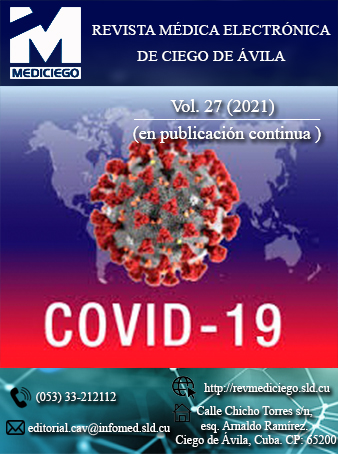Stomatology students' criteria on distance education in a Morphophysiology subject in times of COVID-19
Abstract
Introduction: the COVID-19 pandemic caused the change to the non-face-to-face modality in higher education in Cuba.
Objective: to assess the criteria of first-year Stomatology students on distance education in the subject "Hormonal regulation of metabolism and reproduction", during the pandemic.
Methods: pedagogical research of Stomatology Faculty of Camagüey that covered the period from April to June 2020. It included the 22 students from the first year of medical career, to whom a survey was applied with a questionnaire containing 10 statements. The Likert scale with five categories and a score from five to one was used to express total agreement, agreement, indecision, disagreement or total disagreement. The total mean per item was calculated, as well as the mean of agreements, disagreements and indecision. Ethical principles were met.
Results: the criteria on WhatsApp, mail, telephones and the teacher in the process, obtained the best results with means greater than four. The lowest scores (mean 2,50) were given to cognitive independence and preparation for the assessment; 68,18 % of the students agreed with the quality of the tasks, evaluations and the role of the teacher.
Conclusions: the students considered the role of the teacher crucial, and did not develop their cognitive independence or feel prepared to face a satisfactory evaluation of the subject. The information presented will be relevant to plan the face-to-face stage based on the success and quality of the teaching processDownloads
Published
How to Cite
Issue
Section
License
Those authors who have publications with this journal accept the following terms of the License CC Attribution-NonCommercial 4.0 International (CC BY-NC 4.0):
You are free to:
- Share — copy and redistribute the material in any medium or format
- Adapt — remix, transform, and build upon the material
The licensor cannot revoke these freedoms as long as you follow the license terms.
Under the following terms:
- Attribution — You must give appropriate credit , provide a link to the license, and indicate if changes were made . You may do so in any reasonable manner, but not in any way that suggests the licensor endorses you or your use.
- NonCommercial — You may not use the material for commercial purposes .
- No additional restrictions — You may not apply legal terms or technological measures that legally restrict others from doing anything the license permits.
The journal is not responsible for the opinions and concepts expressed in the works, which are the exclusive responsibility of the authors. The Editor, with the assistance of the Editorial Committee, reserves the right to suggest or request advisable or necessary modifications. Original scientific works are accepted for publication, as are the results of research of interest that have not been published or sent to another journal for the same purpose.
The mention of trademarks of specific equipment, instruments or materials is for identification purposes, and there is no promotional commitment in relation to them, neither by the authors nor by the editor.

























